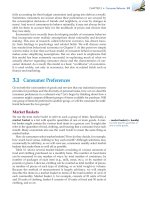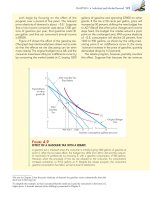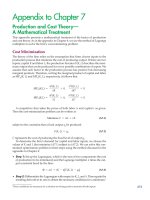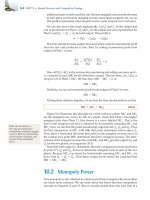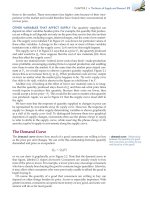(8th edition) (the pearson series in economics) robert pindyck, daniel rubinfeld microecon 297
Bạn đang xem bản rút gọn của tài liệu. Xem và tải ngay bản đầy đủ của tài liệu tại đây (80.66 KB, 1 trang )
272 PART 2 • Producers, Consumers, and Competitive Markets
materials. Your plant has a fixed installation of 5
assembly machines as part of its design.
a. What is the cost function for your plant—namely,
how much would it cost to produce q engines?
What are average and marginal costs for producing q engines? How do average costs vary with
output?
b. How many teams are required to produce 250
engines? What is the average cost per engine?
c. You are asked to make recommendations for the
design of a new production facility. What capital/
labor (K/L) ratio should the new plant accommodate if it wants to minimize the total cost of producing at any level of output q?
9. The short-run cost function of a company is given by
the equation TC = 200 + 55q, where TC is the total
cost and q is the total quantity of output, both measured in thousands.
a. What is the company’s fixed cost?
b. If the company produced 100,000 units of goods,
what would be its average variable cost?
c. What would be its marginal cost of production?
d. What would be its average fixed cost?
e. Suppose the company borrows money and expands
its factory. Its fixed cost rises by $50,000, but its variable cost falls to $45,000 per 1000 units. The cost
of interest (i) also enters into the equation. Each
1-point increase in the interest rate raises costs by
$3000. Write the new cost equation.
*10. A chair manufacturer hires its assembly-line labor for
$30 an hour and calculates that the rental cost of its
machinery is $15 per hour. Suppose that a chair can
be produced using 4 hours of labor or machinery in
any combination. If the firm is currently using 3 hours
of labor for each hour of machine time, is it minimizing its costs of production? If so, why? If not, how
can it improve the situation? Graphically illustrate
the isoquant and the two isocost lines for the current
combination of labor and capital and for the optimal
combination of labor and capital.
1
1
*11. Suppose that a firm’s production function is q = 10L2 K 2 .
The cost of a unit of labor is $20 and the cost of a unit of
capital is $80.
a. The firm is currently producing 100 units of output and has determined that the cost-minimizing
quantities of labor and capital are 20 and 5, respectively. Graphically illustrate this using isoquants
and isocost lines.
b. The firm now wants to increase output to 140 units.
If capital is fixed in the short run, how much labor
will the firm require? Illustrate this graphically and
find the firm’s new total cost.
c. Graphically identify the cost-minimizing level of
capital and labor in the long run if the firm wants to
produce 140 units.
d. If the marginal rate of technical substitution is K/L,
find the optimal level of capital and labor required
to produce the 140 units of output.
*12. A computer company’s cost function, which relates its
average cost of production AC to its cumulative output in thousands of computers Q and its plant size in
terms of thousands of computers produced per year q
(within the production range of 10,000 to 50,000 computers), is given by
AC = 10 - 0.1Q + 0.3q
a. Is there a learning-curve effect?
b. Are there economies or diseconomies of scale?
c. During its existence, the firm has produced a total
of 40,000 computers and is producing 10,000 computers this year. Next year it plans to increase production to 12,000 computers. Will its average cost of
production increase or decrease? Explain.
*13. Suppose the long-run total cost function for an industry
is given by the cubic equation TC = a + bq + cq2 + dq3.
Show (using calculus) that this total cost function is consistent with a U-shaped average cost curve for at least
some values of a, b, c, and d.
*14. A computer company produces hardware and software using the same plant and labor. The total cost of
producing computer processing units H and software
programs S is given by
TC = aH + bS - cHS
where a, b, and c are positive. Is this total cost function
consistent with the presence of economies or diseconomies of scale? With economies or diseconomies of scope?

